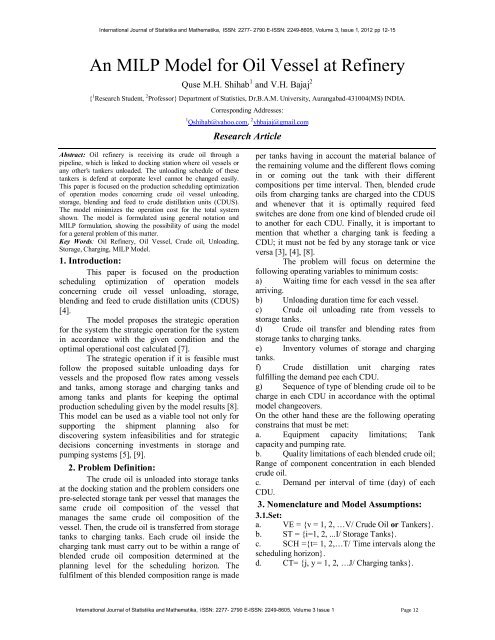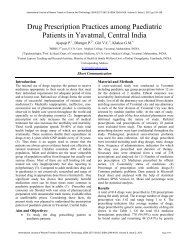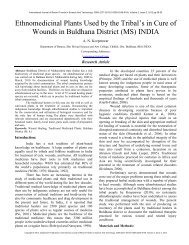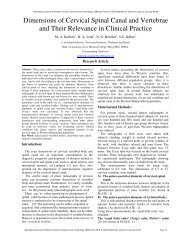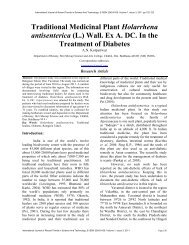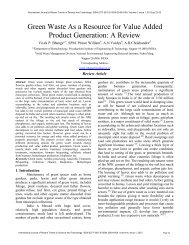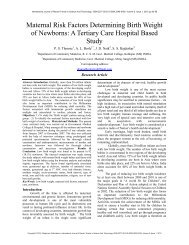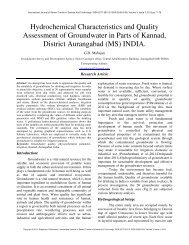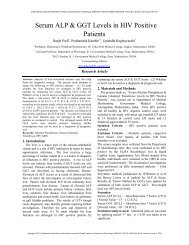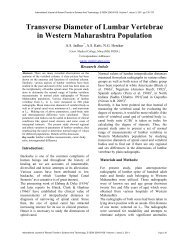An MILP Model for Oil Vessel at Refinery - Statperson
An MILP Model for Oil Vessel at Refinery - Statperson
An MILP Model for Oil Vessel at Refinery - Statperson
Create successful ePaper yourself
Turn your PDF publications into a flip-book with our unique Google optimized e-Paper software.
Intern<strong>at</strong>ional Journal of St<strong>at</strong>istika and M<strong>at</strong>hem<strong>at</strong>ika, ISSN: 2277- 2790 E-ISSN: 2249-8605, Volume 3, Issue 1, 2012 pp 12-15<strong>An</strong> <strong>MILP</strong> <strong>Model</strong> <strong>for</strong> <strong>Oil</strong> <strong>Vessel</strong> <strong>at</strong> <strong>Refinery</strong>Quse M.H. Shihab 1 and V.H. Bajaj 2{ 1 Research Student, 2 Professor} Department of St<strong>at</strong>istics, Dr.B.A.M. University, Aurangabad-431004(MS) INDIA.Corresponding Addresses:1 Qshihab@yahoo.com, 2 vhbajaj@gmail.comResearch ArticleAbstract: <strong>Oil</strong> refinery is receiving its crude oil through apipeline, which is linked to docking st<strong>at</strong>ion where oil vessels orany other's tankers unloaded. The unloading schedule of thesetankers is defend <strong>at</strong> corpor<strong>at</strong>e level cannot be changed easily.This paper is focused on the production scheduling optimiz<strong>at</strong>ionof oper<strong>at</strong>ion modes concerning crude oil vessel unloading,storage, blending and feed to crude distill<strong>at</strong>ion units (CDUS).The model minimizes the oper<strong>at</strong>ion cost <strong>for</strong> the total systemshown. The model is <strong>for</strong>mul<strong>at</strong>ed using general not<strong>at</strong>ion and<strong>MILP</strong> <strong>for</strong>mul<strong>at</strong>ion, showing the possibility of using the model<strong>for</strong> a general problem of this m<strong>at</strong>ter.Key Words: <strong>Oil</strong> <strong>Refinery</strong>, <strong>Oil</strong> <strong>Vessel</strong>, Crude oil, Unloading,Storage, Charging, <strong>MILP</strong> <strong>Model</strong>.1. Introduction:This paper is focused on the productionscheduling optimiz<strong>at</strong>ion of oper<strong>at</strong>ion modelsconcerning crude oil vessel unloading, storage,blending and feed to crude distill<strong>at</strong>ion units (CDUS)[4].The model proposes the str<strong>at</strong>egic oper<strong>at</strong>ion<strong>for</strong> the system the str<strong>at</strong>egic oper<strong>at</strong>ion <strong>for</strong> the systemin accordance with the given condition and theoptimal oper<strong>at</strong>ional cost calcul<strong>at</strong>ed [7].The str<strong>at</strong>egic oper<strong>at</strong>ion if it is feasible mustfollow the proposed suitable unloading days <strong>for</strong>vessels and the proposed flow r<strong>at</strong>es among vesselsand tanks, among storage and charging tanks andamong tanks and plants <strong>for</strong> keeping the optimalproduction scheduling given by the model results [8].This model can be used as a viable tool not only <strong>for</strong>supporting the shipment planning also <strong>for</strong>discovering system infeasibilities and <strong>for</strong> str<strong>at</strong>egicdecisions concerning investments in storage andpumping systems [5], [9].2. Problem Definition:The crude oil is unloaded into storage tanks<strong>at</strong> the docking st<strong>at</strong>ion and the problem considers onepre-selected storage tank per vessel th<strong>at</strong> manages thesame crude oil composition of the vessel th<strong>at</strong>manages the same crude oil composition of thevessel. Then, the crude oil is transferred from storagetanks to charging tanks. Each crude oil inside thecharging tank must carry out to be within a range ofblended crude oil composition determined <strong>at</strong> theplanning level <strong>for</strong> the scheduling horizon. Thefulfilment of this blended composition range is madeper tanks having in account the m<strong>at</strong>erial balance ofthe remaining volume and the different flows comingin or coming out the tank with their differentcompositions per time interval. Then, blended crudeoils from charging tanks are charged into the CDUSand whenever th<strong>at</strong> it is optimally required feedswitches are done from one kind of blended crude oilto another <strong>for</strong> each CDU. Finally, it is important tomention th<strong>at</strong> whether a charging tank is feeding aCDU; it must not be fed by any storage tank or viceversa [3], [4], [8].The problem will focus on determine thefollowing oper<strong>at</strong>ing variables to minimum costs:a) Waiting time <strong>for</strong> each vessel in the sea afterarriving.b) Unloading dur<strong>at</strong>ion time <strong>for</strong> each vessel.c) Crude oil unloading r<strong>at</strong>e from vessels tostorage tanks.d) Crude oil transfer and blending r<strong>at</strong>es fromstorage tanks to charging tanks.e) Inventory volumes of storage and chargingtanks.f) Crude distill<strong>at</strong>ion unit charging r<strong>at</strong>esfulfilling the demand pee each CDU.g) Sequence of type of blending crude oil to becharge in each CDU in accordance with the optimalmodel changeovers.On the other hand these are the following oper<strong>at</strong>ingconstrains th<strong>at</strong> must be met:a. Equipment capacity limit<strong>at</strong>ions; Tankcapacity and pumping r<strong>at</strong>e.b. Quality limit<strong>at</strong>ions of each blended crude oil;Range of component concentr<strong>at</strong>ion in each blendedcrude oil.c. Demand per interval of time (day) of eachCDU.3. Nomencl<strong>at</strong>ure and <strong>Model</strong> Assumptions:3.1.Set:a. VE = {v = 1, 2, …V/ Crude <strong>Oil</strong> or Tankers}.b. ST = {i=1, 2, ...I/ Storage Tanks}.c. SCH ={t= 1, 2,…T/ Time intervals along thescheduling horizon}.d. CT= {j, y = 1, 2, …J/ Charging tanks}.Intern<strong>at</strong>ional Journal of St<strong>at</strong>istiika and M<strong>at</strong>hem<strong>at</strong>ika, ISSN: 2277- 2790 E-ISSN: 2249-8605, Volume 3 Issue 1 Page 12
Quse M.H. Shihab and V.H. Bajaje. CDU = {L= 1, 2,… L/ Crude distill<strong>at</strong>ionunits}.3-2. Parameters:CU V = Unloading cost of vessel v per unit timeinterval.TARR V = Crude oil vessel arrival d<strong>at</strong>e to the dockingst<strong>at</strong>ion.CSEA V = Sea waiting cost of vessel v per unit timeinterval.CSINV i = Inventory cost of storage tank i per unittime interval.CBINV j = Inventory cost of charging tank j per unittime interval.CCHANG L =Changeover cost of CDU L .TLEA V = Crude oil vessel maximum departure d<strong>at</strong>efrom the decking st<strong>at</strong>ion.VS min i = Storage tank minimum capacity.VS max i = Storage tank maximum capacity.VB min j = Charging tank minimum capacity.VB max j = Charging tank maximum capacity.3.3 Variables:3.3.1.Binary VariablesZ j,y,l,t = Variable to denote switch of the blended crudeoil fed toCDU L from charging tank j to charging tank y.XF v,t = Variable to denote if vessel v starts unloading<strong>at</strong> time t.XL v,t = Variable to denote if vessel v finishesunloading <strong>at</strong> time t.D j,l,t = Variable to denote if the crude oil blended incharging tankj charges CDU L <strong>at</strong> time t, otherwise charging tank jcouldbe being fed byStorage tanks.3.3.2Integer Variables.TL v = <strong>Vessel</strong> v unloading Completion time.TF v = <strong>Vessel</strong> v unloading initi<strong>at</strong>ion time.3.3.3Continuous Variables.VS i,t = Volume of crude oil in storage tank i <strong>at</strong> timet.VB j,t = Volume of crude oil in charging tanks j <strong>at</strong>time t.FVS v,i,t = Volumetric flow r<strong>at</strong>e from vessel v tostorage tank i <strong>at</strong> time t.FSB i,j,t = Volumetric flow r<strong>at</strong>er from storage tank i tocharging tank j <strong>at</strong> time t.FBC j,L,t = Volumetric flow r<strong>at</strong>e from charging tank jto CDU L <strong>at</strong> time t.The following are the assumptions <strong>for</strong> the proposedmodel:1.Only one vessel docking st<strong>at</strong>ion <strong>for</strong> crude oilunloading is considered.2. The time applied <strong>for</strong> the changeovers are neglectedand also the transient flowsGener<strong>at</strong>ed during either start up or shut down when achangeover is done.3. Perfect blending is assume <strong>for</strong> each charging tankwhile it is being fed by different Crude oils, andadditional blending time inside the tank is notrequired be<strong>for</strong>e it Chargesthe CDU.4.The composition of the crude oil is decided by theamount of key Component presented in the crude oilor in the blended crude oil. Ingeneral, sulphur is <strong>at</strong>least one of the key components, <strong>for</strong> differenti<strong>at</strong>ingbetween crude oils.4. <strong>Model</strong> M<strong>at</strong>hem<strong>at</strong>ical <strong>for</strong>mul<strong>at</strong>ion:The model focus on minimizing the followingoper<strong>at</strong>ion cost of the system <strong>for</strong> the oper<strong>at</strong>ions ofcrude oil vessel unloading, storage, blending andfeeding to crude distill<strong>at</strong>ion units in an oil refinery[7], then this is the main objective equ<strong>at</strong>ion th<strong>at</strong>represents the total oper<strong>at</strong>ion cost of the system:Cost = [(TL − TF + 1)CU ] + [(TF − TARR ) CSEA ] + [VS ,, + VS ,, CSINV ] + [ ( VB2, + VB , ) CBINV /2] + [CCHANG . Z ,,, ] … . (1) The above equ<strong>at</strong>ion is subject to the followingconstrains:4.1 <strong>Vessel</strong> Arrival and Departure Oper<strong>at</strong>ionRules.Each <strong>Vessel</strong> must arrive to the docking st<strong>at</strong>ion <strong>for</strong>unloading only once: X F , = 1 , ∀ v ∈ VE … (2)Each vessel leaves the docking st<strong>at</strong>ion only once: X L , = 1 , ∀ v ∈ VE … (3)The unloading initi<strong>at</strong>ion time is:TF = t x F , , ∀ v ∈ VE … (4)The unloading completion time is:TL = t x L , , ∀ v ∈ VE … (5)Each vessel must start unloading either after or onthe arrival timeestablished <strong>at</strong>the planning level:TF ≥ TARR , ∀ v ∈ VE … (6)Each vessel must finish unloading up to one intervalof time be<strong>for</strong>e the maximumdeparture time established <strong>at</strong> the planning level:TL < TLEA , ∀ v ∈ VE, ∀ v ≠ V … (7)Copyright © 2012, St<strong>at</strong>person Public<strong>at</strong>ions, Iintern<strong>at</strong>ional Journal of St<strong>at</strong>istika and M<strong>at</strong>hem<strong>at</strong>ika, ISSN: 2277- 2790 E-ISSN: 2249-8605, Volume 3 Issue 1 2012
Intern<strong>at</strong>ional Journal of St<strong>at</strong>istika and M<strong>at</strong>hem<strong>at</strong>ika, ISSN: 2277- 2790 E-ISSN: 2249-8605, Volume 3, Issue 1, 2012 pp 12-15Except <strong>for</strong> the last vessel:TL ≤ TLEA , ∀ v = V … (8)Minimum dur<strong>at</strong>ion of the vessel unloading is twotime intervals:TL − TF ≥ 1 , ∀ v ∈ VE … (9)The preceding vessel must finish unloading one timeinterval be<strong>for</strong>e the nextvessel in the sea arrives and start to unload:TF ≥ TL + 1 , ∀ v ∈ VE … (10)4.2 M<strong>at</strong>erial Balance Equ<strong>at</strong>ions <strong>for</strong> the StorageTank.The crude oil in storage tank i <strong>at</strong>time t+1 must be equal to the crudeoil in storage tank i <strong>at</strong> time t plus the crude oiltransferred from vessel v tostorage tank i <strong>at</strong> time t taking a way the crude oiltransferred to chargingtanks j <strong>at</strong> time t:VS , = VS , , ∀t = 1 … (11)VS , = VS , + FVS ,,, − FSB ,,∈ SCH … (12), ∀i ∈ ST, ∀tVolume capacity limit<strong>at</strong>ion <strong>for</strong> storage tank i:VS ≤ VS , ≤ VS , ∀i ∈ ST, ∀ t ∈ SCH … (13)4.3 M<strong>at</strong>erial Balance Equ<strong>at</strong>ion <strong>for</strong> the ChargingTank.The crude oil blended in the charging tank j<strong>at</strong> timet+1 must beequalto the crude oil in the charging rank j <strong>at</strong> time t plusthe crude oil transferredfrom the storage tanks taking away the crude oiltransferred to the CDU L <strong>at</strong>time t:VB , = VB , , ∀ t = 1 … (14)VB , = VB , + FSB ,, − FBC ,,, ∀j ∈ CT, ∀t∈ SCH … (15)Volume capacity limit<strong>at</strong>ion <strong>for</strong> charging tank j:VB ≤ VB , ≤ VB , ∀ j ∈ CT, ∀t ∈ SCH … (16)4.4 Oper<strong>at</strong>ing Rules <strong>for</strong> Crude <strong>Oil</strong> Charging toCrude Distill<strong>at</strong>ion Units.As it was st<strong>at</strong>ed above eachCDU L only can be charged by one chargingtank j <strong>at</strong> time t: D ,, = 1, ∀L ∈ CDU, ∀t ∈ SCH … (17)On the other hand, each charging tank j can charge <strong>at</strong>most one CDU L <strong>at</strong> time t: D ,, ≤ 1 , ∀j ∈ CT , ∀t ∈ SCH … (18)If the CDU L is charged by crude oil blended j<strong>at</strong> time t and after is chargedby crude oil blended y <strong>at</strong> time t+1 then, changeovercost must be involved. Thefollowing is the condition th<strong>at</strong> confirms th<strong>at</strong>changeover cost shall be charged:5. Numerical Example:Z ,,, ≥ D ,, + D ,, − 1 , ∀j, y (j ≠ y) ∈ CT, ∀L ∈ CDU, ∀t ∈ SCH (19)Table1.Shows the system in<strong>for</strong>m<strong>at</strong>ion <strong>for</strong> numerical example [2].Scheduling Horizon (# of unit times : days) 8No. of <strong>Vessel</strong> arrivals 2Arrival time Amount of crude <strong>Oil</strong> Key component concentr<strong>at</strong>ion<strong>Vessel</strong> 1 1 100 0.01<strong>Vessel</strong> 2 5 100 0.06No. of Storage Tanks 2Storage Tanks Capacity Initial oil Amount Key component concentr<strong>at</strong>ionTank 1 100 25 0.01Tank 2 100 75 0.06No. of Charging Tanks 2Charging Tanks Capacity Initial oil Amount Initial component concentr<strong>at</strong>ion (Min-Max)Tank 1 100 50 0.02 (0.015–0.025)Tank 2 100 50 0.05 (0.045 – 0.055)No. of CDUS 1Unit Costs involved in vessel oper<strong>at</strong>ion Unloading Cost = 8,Sea waiting Cost = 5Tank Inventory Unit Cost Storage Tank = 0.08,Charging Tank = 0.05Unit changeover cost <strong>for</strong> charged oil switch50 (independent of sequence and CDU)Blended oils demand from charging tanks To CDU S Blended oil 1 : 100,Blended oil 2 : 100,Blended oil 3: 100.Maximum flow r<strong>at</strong>e from vessel to one storage tank 50Maximum flow from one storage tank to one charging tank 40Maximum total flow r<strong>at</strong>e from one storage tank to charging tanks <strong>at</strong> any time 40Intern<strong>at</strong>ional Journal of St<strong>at</strong>istiika and M<strong>at</strong>hem<strong>at</strong>ika, ISSN: 2277- 2790 E-ISSN: 2249-8605, Volume 3 Issue 1 Page 14
Quse M.H. Shihab and V.H. BajajThe given d<strong>at</strong>a <strong>for</strong> quantifying volumes and flowr<strong>at</strong>es are given in barrels x 10,000 and barrels pertime interval x 10,000 respectively, changeover costsare given in US$ x 1.000; sea waiting costs andunloading costs are given in US$ x1.000 per timeinterval (day) and tank inventory unit cost are givenin US$ x 0.1 per oil barrel. There<strong>for</strong>e, optimal valueresults will be in US$ x 1.000.Table 2. Optimal Unloading Starting D<strong>at</strong>e <strong>for</strong> <strong>Vessel</strong>s.<strong>Vessel</strong>s <strong>Model</strong> A <strong>Model</strong> B1 3 22 7 7Table 2. points out the comparisons of the optimalunloading starting up d<strong>at</strong>e results from both models<strong>for</strong> numerical example vessel 1 stars to unload onday (s) <strong>for</strong> model'A'; th<strong>at</strong> is one day more thanmodel 'B'which considers this oper<strong>at</strong>ion on day 2.Instead, <strong>for</strong> vessel 2 both coincide starting unloadingon day7.The optimiz<strong>at</strong>ion model Table 3.Involved36 discretevariables, 192 single variables, and 331 constraints[2]. The modelling system G.A.M.S. [1]. Was used<strong>for</strong> setting up the optimiz<strong>at</strong>ion model and thenumbers of variables and constraints were reducedby considering the d<strong>at</strong>a structure of binary variables.The problem was solved by OSL, IBM [6]. <strong>An</strong> IBMRS- 6000 in 17.5 of CPU time.Table 3. Comparison of Optimal ResultItems <strong>Model</strong> A <strong>Model</strong> BOptimal value (US$ X 1.000) 217.667 206.95Equ<strong>at</strong>ions and constrains 331 552Single Variables 192 337Discrete Variables 36 116Iter<strong>at</strong>ions 1.695 4.393Solving time (second) 17.1 5.21The optimal results gener<strong>at</strong>ed by model 'B' with Noomission of any d<strong>at</strong>a given by model ‘A’ are shownand compared in advance with the optimal results ofmodel 'A' in table 3.6. Concluding Remarks:1) The situ<strong>at</strong>ions may be causing abig part of the difference between both optimal valuesince the optimal oper<strong>at</strong>ional schedule of <strong>Model</strong> 'A'should be paying more money in inventory total cost.On the other hand, <strong>Model</strong> 'A' results is paying oneday more of sea waiting cost (US $ 5,000) thanmodel 'B' results as is indic<strong>at</strong>ed in table (2).2)The optimal results <strong>for</strong> numericalexample are better <strong>for</strong> model 'B' indic<strong>at</strong>ing a totaloper<strong>at</strong>ional cost saving <strong>for</strong> the problem conditions ofUS$ 10,717 (4.92%) cost reduction with respect tomodel 'A' during the 8 day scheduling horizon inaccordance with the results showed in table (1).References:[1] Brooke, D. Kendrick, A. Meeraus and R. Raman,"GAMS" (General Algebraic <strong>Model</strong>ing system), auser's guide, Washington: GAMS DevelopmentCorpor<strong>at</strong>ion, (1997)[2] <strong>An</strong>nual Bulletin,“<strong>Oil</strong>, Gas and Minerals st<strong>at</strong>istics,"published by ministry of oil and minerals, Republic ofYemen, pages 50-55, (2009).[3] F.D. Fagundez, A.E.Xavier, J.L.D. Faco,"ContinuousNonlinear Programming Techniques to solvescheduling problems,” In<strong>for</strong>m<strong>at</strong>ica journal,Vol. 20,No.2, pages 203-216. (2009).[4] G.K.D.Saharidis and M.G.Ierapetritou,"Scheduling ofLoading and unloading of crude oil in a refinery withoptimal mixture prepar<strong>at</strong>ion", Industrial andEngineering chemistry research,vol. 48, No. 5, pages2624-2633. (2009).[5] G. Robertson, A. Plazoglue and J.A. Romagnoli,"Multi Level simul<strong>at</strong>ion approach <strong>for</strong> the crude oilloading/ unloading scheduling problem'',Computer &chemical Engineering,Vol. 35, Issue 5,pages 817-827,(2011).[6] IBM.OSL, "Optimiz<strong>at</strong>ion subroutine Library," Guideand reference release 2, Kingston N.Y. (1991).[7] N. Shah, "M<strong>at</strong>hem<strong>at</strong>ical programming technique <strong>for</strong>crude oil scheduling," computer and chemicalEngineering,Vol.20, pages S1227-S1232. (1996).[8] R.M.Tahar, and W.K. Abduljabbar,“<strong>An</strong>ovelTransporting system model <strong>for</strong> oil refinery,"American journal of Engineering and applied science.Vol. 3, No.1,pages 138-143, (2010).[9] U. Yuzgec, A. Palazoglu and J.A. Romagnoli,"<strong>Refinery</strong> scheduling of crude oil unloading storageand processing using model predictive controlstr<strong>at</strong>egy”, Computer and chemical Engineering, Vol.34,pages 1671-1686, (2010).[10] J.A.Persson and M.G.Lundgren,"Shipment planning <strong>at</strong>oil refineries using column Gener<strong>at</strong>ion and validinequalities”, European journal of oper<strong>at</strong>ional research,Vol.163, pages 631- 652, (2005).Copyright © 2012, St<strong>at</strong>person Public<strong>at</strong>ions, Iintern<strong>at</strong>ional Journal of St<strong>at</strong>istika and M<strong>at</strong>hem<strong>at</strong>ika, ISSN: 2277- 2790 E-ISSN: 2249-8605, Volume 3 Issue 1 2012


